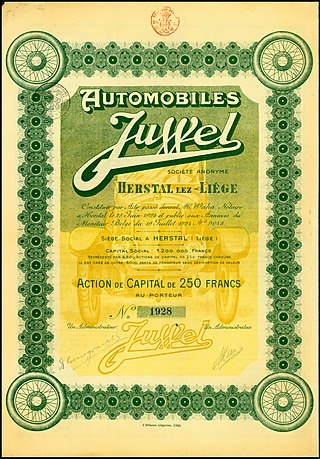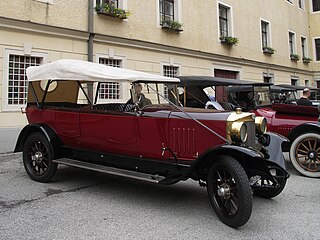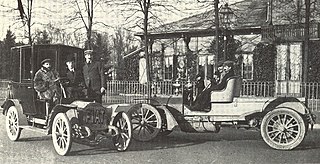Related Research Articles

Automobiles Delaunay-Belleville was a French luxury automobile manufacturer at Saint-Denis, France, north of Paris. At the beginning of the 20th century they were among the most prestigious cars produced in the world, and perhaps the most desirable French marque.

The Daimler Company Limited, prior to 1910 The Daimler Motor Company Limited, was an independent British motor vehicle manufacturer founded in London by H. J. Lawson in 1896, which set up its manufacturing base in Coventry. The company bought the right to the use of the Daimler name simultaneously from Gottlieb Daimler and Daimler-Motoren-Gesellschaft of Cannstatt, Germany. After early financial difficulty and a reorganisation of the company in 1904, the Daimler Motor Company was purchased by Birmingham Small Arms Company (BSA) in 1910, which also made cars under its own name before the Second World War. In 1933, BSA bought the Lanchester Motor Company and made it a subsidiary of Daimler Company.
The Abadal was a Spanish car manufactured between 1912 and 1923, named after Francisco Abadal. Considered a fast luxury car, it was closely patterned on the Hispano-Suiza and offered in two models. One had a 3104 cc four-cylinder engine while the other had a 4521 cc six-cylinder engine.
The AGR was an English automobile built by Ariel & General Repairs of Brixton between 1911 and 1915.

Marquis Jules Félix Philippe Albert de Dion de Wandonne was a French pioneer of the automobile industry. He invented a steam-powered car and used it to win the world's first auto race, but his vehicle was adjudged to be against the rules. He was a co-founder of De Dion-Bouton, the world's largest automobile manufacturer for a time, as well as the French sports newspaper L'Équipe.

Singer Motors Limited was a British motor vehicle manufacturing business, originally a bicycle manufacturer founded as Singer & Co by George Singer, in 1874 in Coventry, England. Singer & Co's bicycle manufacture continued. From 1901 George Singer's Singer Motor Co made cars and commercial vehicles.
F. B. Stearns and Company, later known as F. B. Stearns Company was an American manufacturer of luxury cars in Cleveland, Ohio marketed under the brand names Stearns from 1900 to 1911 then Stearns-Knight from 1911 until 1929.

The Rumpler Tropfenwagen was a car developed by Austrian engineer Edmund Rumpler.
The Flaid was a Belgian automobile manufactured from 1920 until 1921 in Liège. A 10/12 hp light car with 1095 cc four-cylinder engine, it was designed for export to Britain. A stand was booked at the 1920 British Motor Show but the car never appeared.

The Juwel was a Belgian automobile manufactured from 1923 until 1927 in Waremme by Société des Automobiles Juwel. Initial plans called for a mass-produced 1100 cc four cylinder tourer and two models were shown at the 1922 Brussels Motor Show. Bodies offered included open 2 and 4 seat cars, a 3 seat sports cars, two door saloon and a light delivery van. Financial problems restricted the numbers made. A new range of cars were shown in 1924 now with overhead valve engines and front wheel brakes but production remained limited.
The IENA was an Italian automobile manufactured by Industria Economica Nazionale Automobili di Tommasi et Rizzi in Lodi from 1921 until 1925. Two versions were made, a 750 cc light car or 1096 cc sports car, it used a French four-cylinder Chapuis-Dornier engine.
The La Ponette was a French automobile manufactured from 1909 until 1925. The very small car builder began production with a single-cylinder 697 cc car which was very similar to a small Renault. This was followed in 1911 by a four-cylinder 1592 cc Ballot-engined vehicle, which was built until 1920. A few minor models were also made using various proprietary engines. The parent company, the Société des Automobiles La Ponette, collapsed in 1925, and the marque ceased production.
The Elizalde was a Spanish automobile manufacturer from 1914 until 1928.

The Empire was an American automobile manufactured from 1910 until 1919. Marketed as "the little aristocrat", the Empire 20 was a four-cylinder shaft-driven runabout built in Indianapolis. The model "A" was a conventional runabout for three passengers with a rumble seat. The model "B" had two bucket seats, a longer hood and was geared higher to attain faster speeds.
The Buckingham was an English automobile manufactured by the Buckingham Engineering Company in Coventry from 1914 until 1923. The company had made cars under the Chota name from 1912.
The Skirrow was an English automobile manufactured between 1936 and 1939. A midget racing car produced by Harry Skirrow, based in Ambleside, Cumbria, it used a 1000 cc JAP engine and was both unusual and highly noteworthy in having chain drive to all four wheels.

Steyr was an Austrian automotive brand, established in 1915 as a branch of the Österreichische Waffenfabriks-Gesellschaft (ÖWG) weapon manufacturing company. Renamed Steyr-Werke AG in 1926 and merged with Austro-Daimler and Puch into Steyr-Daimler-Puch AG, it continued manufacturing Steyr automobiles until 1959.

The Fiat 1 or Fiat 1 Fiacre was produced by Fiat from 1908 to 1910. It had an engine capacity of 2,200 cc, which produced 16 PS (11.8 kW). The car had top speed of 70 km/h (43 mph).

From 1931 to 1939, Daimler-Benz AG produced three cars with rear engine as well as a few prototypes. The production numbers remained quite low for each of these models, especially compared to the production of classical front-engine Mercedes cars.
References
- ↑ Odin, L.C. World in Motion 1939 - The whole of the year's automobile production. Belvedere Publishing, 2015. ASIN: B00ZLN91ZG.
- Wise, David Burgess (2000). David Burgess Wise (ed.). The New Illustrated Encyclopedia of the Automobile. Lance Cole. BookSales Inc. ISBN 978-0-7858-1106-0.
- Georgano, G. N. (1970). A History of Sports Cars (Excerpt). Dutton. p. 191. ISBN 0-17-148024-4 . Retrieved 2007-12-03.